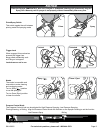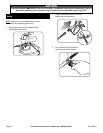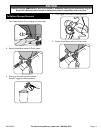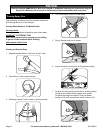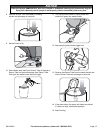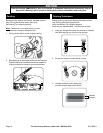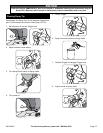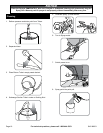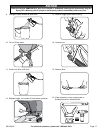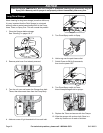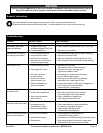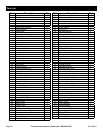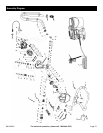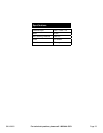
Page 19For technical questions, please call 1-800-444-3353.SKU 68001
NOTICE
Clean the Sprayer IMMEDIATELY after use. Delayed or inadequate cleaning will permanently clog the
Spray Gun. Warranty void if sprayer is not properly cleaned immediately after every use.
Troubleshooting
Problem Possible Causes Likely Solutions
Decreased output. Obstructed trigger. Clean around trigger to ensure movement.
Inconsistent paint ow,
blobs and splatters.
1. Clogged Spray Tip or
damaged/clogged Fluid Filter.
2. Contaminated paint.
1. Clean, adjust or replace Spray Tip or Fluid Filter.
2. Remove paint and lter it.
Paint surface is bumpy or
has orange peel texture.
1. Paint is applied too thick.
2. Incorrect paint volume.
3. Insufcient air pressure.
4. Paint gun too far from paint
surface during spraying.
1. Paint must be thinned properly before spraying.
2. Adjust Fluid Control Knob.
3. Adjust Air Regulator and Air Adjustment Valve.
4. Hold spray gun closer to surface during spraying.
Paint sags or runs. 1. Excess thinning of paint.
2. Paint applied too thick.
3. Paint gun too close
to work surface.
4. Uneven or hesitant
motion of spray gun.
5. Excess overlapping of
each spray stroke.
1. Recheck paint viscosity.
Add unmixed paint to thicken mixture.
2. Apply thinner coats, allowing paint
to get tacky between coats.
3. Move spray gun further back from paint
surface when applying paint.
4. Keep spray gun moving during painting.
Hesitations can cause sags or runs.
5. Overlap each stroke to keep the coverage even,
but be aware that you are adding
coat thickness by overlapping.
Blotchy surface (blushing)
or uneven color.
1. Paint dries too slowly.
2. Uneven paint application.
3. Work material absorbs
paint unevenly.
1. Use less thinner or add a drier.
2. Start each stroke off the work material
and overlap each stroke consistently.
3. Use a conditioner or sealer coat
before applying the nish coat.
Spots on surface
with light center (sh eyes).
1. Paint mixture too thin.
2. Improper primer or
incompatible surface.
3. Surface contamination.
1. Add undiluted paint to thicken mixture.
2. Check manufacturer’s recommendations
for primer or compatible surfaces.
3. Clean surface thoroughly with
thinner before applying paint.
Spots on surface with dark
center (contamination).
1. Dust or dirt on surface.
2. Insufciently sanded.
3. Raised grain.
1. Clean surface with compressed air
or tack cloth before painting.
2. Sand wood to a sufciently ne grit before painting.
3. Wipe wood surface with thinner to raise grain,
then sand with ne grit to knock off “hairs”.
Disposal Instructions
Improper disposal of paint is against the law and a health and environmental hazard.
Dispose of paint through local recycling facility. Visit www.earth911.com to nd a facility near you.



